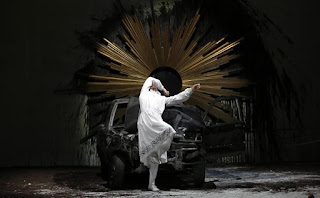Requiem by Wolfgang Amadeus Mozart.
Conductor Rory Macdonald. Stage director, costume and lighting designer Romeo Castelluci. Associate director and costume designer. Silvia Costa. Dramaturg Piersandra di Matteo. Soprano Siobhan Stagg. Alto Sara Mingardo. Tenor Martin Miterrutzner, Bass David Greco. Treble Luca Shin. Adelaide Symphony Orchestra. Adelaide Festival Chorus. Chorus Master Brett Weymark. Australian Dance Theatre. A co-production of Festival d’Aix-en-Provence with Adelaide Festival, Theater Basel, Wiener Festwochen and Palau de les Arts Reina Sofia. Festival Theatre. Adelaide Festival Centre. February 28. March 1,3 and 4 2020.
Reviewed by Peter Wilkins
Romeo Castelluci’s interpretation of Wolfgang
Amadeus Mozart’s Mass for the Dead Requiem offers a fiercely
uncompromising vision of life’s inevitable extinction. His staging of Mozart’s Requiem
on the Adelaide Festival Theatre stage prophesies impending doom in the advent
of inevitable death. Mozart’s Mass for the Dead, written in part shortly before
his premature death in 1791 at the age of 35 and completed at his widow
Constaze’s request by Mozart’s student Franz Xaver Sussmayer confronts the fearful
premonition of his mortality and death.
Castelluci casts Mozart’s Requiem as a
contemporary initiation into the solemn nature of ultimate extinction. Under
the baton of conductor, Rory McMahon, the Adelaide Festival Orchestra conjures
a sublime rendition of Mozart’s complex composition, layered with sobriety,
gravity and the inescapable reality of our virtual demise, comforted by faith
and the hope of a celestial salvation in the hope of eternal rest. Raphael
Picon’s musical montage ranges in its powerful diversity from the opening
Gregorian a capella chant to the final offertory of Domine Jesu Christe by the
Adelaide Festival Chorus, comprising the superb Adelaide Chamber Singers and
the State Opera Chorus who have thrilled audiences with their work in Barrie
Kosky’s Saul and The Magic Flute. They are no less uplifting in
Requiem. Mozart has composed far more than a masterwork, lauding the repose
of departed souls. His is a theatrical metaphor, steeped in faith and choral
ritual, aroused by musical observance of the rituals of the requiem.
Castelluci presents a scenario of imagery that
is both inspiring and disturbing. From the opening Plainchant, eerily sung
behind the scene, Castelluci presents an old woman before a plain single bed
and in front of a television announcing reports on drought and fires. The
images of the nation’s recent disastrous Summer are inescapable references to
natural disaster. Ritual and symbolism combine in a fresco of images expounding
life’s fateful trajectory to eternal rest or damnation. The profundity is
startling from the stark image of the old woman in her bed to the young girl
daubed with coloured liquid and hunf onto the backdrop as sacrificial carcass
or the Australian Dance Theatre dancers tableaud against the burnt out car as
roadkill to the colourrful dance of folkroloric Eastern European ritual. Treble
(Luca Shin) enters kicking a skull before him along the stage. His purity of
voice transcends the horror of his action.
Bass David Greco scatters ash across the body of the young woman
(Jacinta Hriskin) and the chorus perform the rhythmic choreography of Evelin
Facchini while singing and observing the cyclical nature of death and
celebration. In a work so heavily layered with imagery and symbolism, the
audience is cajoled, mesmerized and challenged to consider Castelluci’s Atlas
of Extinction. There is a lament for all that is lost, far more than mere death
but a warning to civilization to beware the ultimate apocalypse. Only mercy,
sung with such soul by alto Sara Mingardo with the Chorus in O Gottes Lamm can
offer hope for salvation. This theme is echoed in Siobhan Stagg’s emotional
rendition of the Communion.
Castelluci’s piece de resistance is the image
of utter extinction. During the performance, his Atlas of Extinction projects
the history of extinction of animals , man, lakes, architecture ,Adelaide
iconic structures, famous religious art, thought and finally me. All nature
must meet its extinction and the inevitability of this prophetic truth
overwhelms as the floor slowly rises and detritus and soil fall to the ground
during the inevitable prediction that we are confronting our extinction and
Castelluci’s theatrical triumph leaves us only, as Mozart’s masterwork has
done, at celestial mercy.



